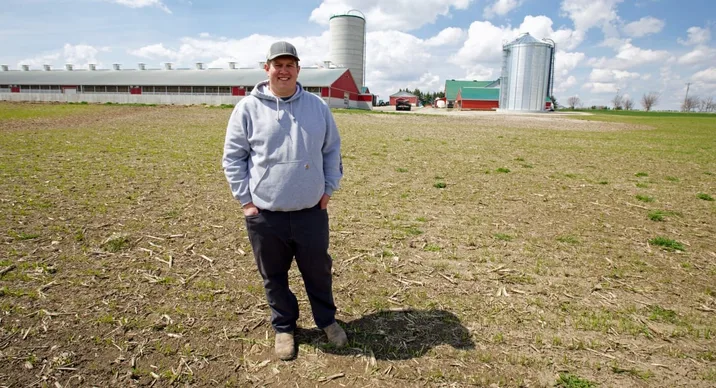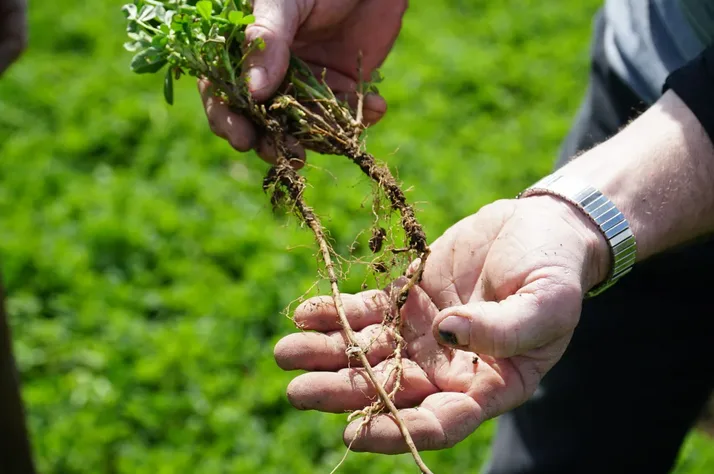
How regenerative farming could help Canada meet its new emission targets
Standing in a field of alfalfa, 79-year-old Carl Israel picks up a handful of soil, smells it and remarks on its sweetness.
"I remember my dad saying … that when you're out there all day on the plow, you really get an appetite because of the smell of the soil."
That same soil, crucial to healthy crops and livestock, could also play a role in reducing greenhouse gas emissions and help the Canadian government meet ambitious targets it announced recently.
Carl's grandson Brett, 24, says that by adopting a series of regenerative farming techniques like the ones used by his family's 3Gen Organics operation, farmers can reduce agricultural emissions while simultaneously improving soil health.
"Farmers are on the forefront of climate change, we are seeing more intense weather systems," Brett Israel said. "So we need to build resilient systems to overcome these issues and enrich the environment around us."

Claudia Wagner-Riddle, an agro-meteorologist at the University of Guelph, says cover cropping, integrating livestock and increased diversity are key components to using agriculture to fight climate change through improved soil health. (Mia Sheldon/CBC)
Building those resilient systems starts with allowing soil to capture and sequester more carbon through cover cropping, promoting crop diversity, protecting watersheds and integrating livestock into the farm system, according to Claudia Wagner-Riddle, an agro-meteorologist at the University of Guelph who studies agricultural emissions and greenhouse gases.
Agriculture is responsible for 10 per cent of Canada's greenhouse gas emissions. As part of its strategy to address climate change, the government earmarked $270 million in its April 19 federal budget to support agriculture and climate-smart solutions, including regenerative farming.
"They [regenerative practices] are making the system more resilient to extreme climate events or weather events," Wagner-Riddle said, adding that keeping carbon sequestered in the soil in organic compounds means it is not easily accessible to be returned to the atmosphere. "That is the magic of carbon sequestration."
Brett Israel switched to regenerative farming five years ago, which includes rotating through 20 different types of crops on his organic pig farm in Wallenstein, Ont.
"We've been able to integrate forages back into our cropping system, keeping the ground covered over winter, reducing our tillage which helps us sequester more atmospheric carbon into our soils, and ultimately trying to balance our livestock with our crop land."
Crumbling soil in his hands, tracing the intricate root systems and nitrogen nodules, Israel says planting crops like alfalfa, oats or winter wheat throughout the year instead of leaving the ground bare over the winter — a practice called cover cropping — makes his soil healthier.
"The cover crop might not be feeding my physical livestock or feeding people, [but] it's feeding the biology below our ground right now."

Brett Israel's family farm in Wallenstein, Ont., rotates through 20 different types of crops and has reduced tillage to help keep the soil healthy. (Ousama Farag/CBC)
It can take up to a decade to see the benefits of regenerative farming and carbon sequestration, and the practice has remained a relatively fringe approach to agriculture until recently. But a growing body of research is showing its effectiveness in reducing agricultural emissions and improving the soil.
"In the last 10 years, there has been a lot of effort put into from various organizations to raise awareness of soil health to better measure and be able to say when the soil is healthy or not," said Wagner-Riddle.
Standing between two fields at the university, one that uses regenerative practices and one that does not, the side using regenerative techniques is green with the remains of a radish crop. The other dry and brown. Wagner-Riddle says leaving fields dormant is a missed opportunity for farmers. The dormant land could be growing crops, feeding the soil and helping to offset climate change.

Claudia Wagner-Riddle walks between two fields at the University of Guelph. The one that uses regenerative techniques is green with the remains of a radish crop that continues to feed microbes in the soil, while the one that does not is bare. (Mia Sheldon/CBC)
But a big hurdle, she says, is persuading farmers of the benefits.
"Overall, it's extra work for the farmers, right?," she said. "Basically they have to plant the [cover] crop by the seed without getting an income, because you're not selling it to feed people or animals. You're using it to feed the soil."
Another issue hampering wider adoption has been the difficulty of quantifying the economic and environmental impact of regenerative farming, because hard data has been scarce. Wagner-Riddle says she hopes to help address those concerns later this year when she publishes results summarizing the first three years of her study of the soil's ability to store carbon.
Blain Hjertaas has also been trying to get other farmers to adopt regenerative farming practices. He started using them himself in the late '90s on his cattle farm in southeastern Saskatchewan, helping foster both the overall health of the soil and the growth of the microbes living and dying in it that sequester carbon.
"In my mind it's really simple. There are three types of agriculture. There's degenerative, in which the soil health is going down. In sustainable [agriculture], it stays the same," he explained.
"Regenerative [agriculture] is when we turn the corner and we say, oh, we're going to make it go better again. So that's regenerative."
In recent decades, tilling has been blamed for disturbing soil and advancing erosion. The practice has mostly subsided on the prairies, but Hjertaas says much more needs to change to make a larger dent in agricultural emissions.
"We got to capture that sun up there, get photosynthesis to happen, and get that sugar down into the roots, which feeds the organisms below our feet."

A cover crop may not feed people or livestock, but it helps feed microbes below ground that keep the soil healthy and productive. (Mia Sheldon/CBC)
Hjertaas uses rotational grazing with his livestock to encourage plant regrowth, for example, naturally distributing nutrients and allowing roots to grow deeper.
"On this farm, we are sequestering enough carbon to more than offset 400 Canadians' footprint [per year]" he said. The average Canadian's carbon footprint is 15.6 tonnes annually.
Hjertaas is confident in those numbers, but admits it is not an exact science. And unlike organic farming, there are no regulatory bodies for regenerative agriculture and the practice remains more of philosophy.
Even so, major corporations are recognizing the benefits and getting involved.
Cargill has pledged to promote regenerative agriculture on more than four million hectares of farmland in North America by 2030.
Walmart has also announced its intent to become a regenerative company.
General Mills began working with farmers across North America in 2019 to advance regenerative agriculture over about 400,000 hectares, a project that includes 45 oat farmers in Saskatchewan. The company offers soil testing and coaching to participating farmers, to help offset its own carbon footprint.
Hjertaas is one of the trainers with General Mills. "They have very little greenhouse gas emissions in their own processing, but most of the greenhouse gas emissions come from agriculture. So that's why they want to work with us as the farmers producing their products, to get us to lower our greenhouse gas emissions."
Agriculture is an industry steeped in tradition, and Israel admits it can be a struggle to get some farmers to try something new.
However, he tells others it's actually like going back to how his great-grandfather used to farm the same land before climate change was a crisis.
"At the start you get some questions and some strange looks from the neighbours," he said, noting the unconventional grains or crops he might be growing as a pork producer. But he's hopeful more farmers will start using regenerative agriculture.
"These [climate change issues] are universal problems, and farmers should be taking a step."
This article was originally published by CBC News and written by Mia Sheldon.










